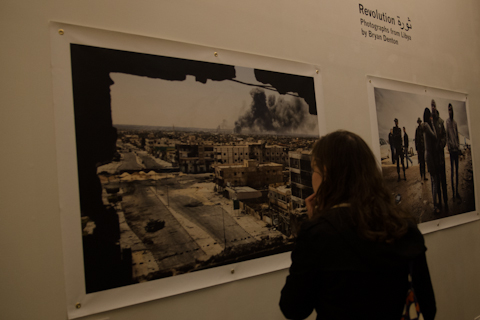
This was the first significant moment in the last six months of the Libyan uprising upon which Bryan Denton wasn’t able to frame in his lens.
“Part of me wishes I was there,” said Denton, when asked how it felt to miss the dictator’s death at the hands of rebel forces.
As a freelance photojournalist, Denton’s work has been featured in a range of publications, from Time magazine to the New Republic. But his photographs from Libya – shot in part for the New York Times – have garnered attention from many of his colleagues for their quality and story-telling capacity.
“Bryan’s work from a string of contested Libyan towns and cities has repeatedly brought readers inside the war in ways few on the beat have matched,” wrote C.J. Chivers, the Pulitzer-prize winning journalist, in an article for the New York Times Lens blog in May. Chivers worked with Denton in Libya this spring.
Denton photographs illustrate his willingness to be on the ground at the center of crisis – capturing the streets of Libya’s besieged capital Tripoli, or conflict-ridden Misrata, the site of innumerable battles between rebel forces and the government. His demeanor, knowledge of the region, and ability to speak Arabic allowed him to gain the access and trust of the Libyans he photographed.
His proximity to the conflict comes through in the gallery’s first frame: a dark-haired rebel perched atop a wind-blown sandy mound, wearing sunglasses, jeans and coat, holds an AK-47 trained over the horizon. Denton appears to be no further than 15 feet from the rebel when he took the shot.
Other photographs feature rebels sitting, smoking, firing their weapons down debris-filled streets and or watching intensely from the windows of passing cars. The gallery, which shows empty towns, broken homes and neighborhoods in Libya, is interspersed with moments of celebration, as rebel forces took over Gadhafi’s compound at the end of August, for instance.
Ten years ago when Denton stood on New York University’s campus as a new student at Tisch School for the Arts’ department of photography and imaging, he was thinking about pursuing a career in fashion photography when the planes hit the Twin Towers.
“The world got infinitely bigger that day,” said Denton. “I wanted to explore.”
This exploration started with a change in academic focus, and led him to engage in a world that was foreign, politically complicated and constantly in flux.
Denton went on to study Arabic and Middle Eastern and Islamic Studies and spent a semester in Amman, Jordan, before graduating in 2005. He then relocated to Middle East, and began accepting freelance jobs covering conflict in Afghanistan, Georgia, Lebanon, Iraq and finally Libya. He now lives in Beirut.
“We are watching a shifting paradigm,” said Denton, of the Middle East today. “There is a lot of hope and a lot of fear.”
For family members, Denton’s success in capturing and cataloguing events like the Libyan revolution seemed inevitable.
“When I look back, I can’t imagine him doing anything else,” Margi Denton, 57, said of her son’s choice of profession, given his studies on the Middle East, knowledge of the language, and love of photography.
Bryan Denton’s stay in New York is only temporary – he’ll be here a week before heading back to Lebanon. While he doesn’t know the location yet, Denton expects to be back on the ground, camera in hand, soon.
Even with Gadhafi’s death, thought by many to be the end of the revolution, Denton hasn’t crossed Libya off his list of conflict areas.
“The hard part will be fighting for the peace,” Denton said, while glancing around the room at his prints.
Before being whisked away for another round of introductions, or reintroductions, Denton pointed to the two images in the gallery he thought most relevant to understanding the chances for peace in post-Gadhafi Libya.
The first is a photograph taken of words, scribbled in Arabic, on a wall inside a small home. The text describes a group of armed fighters thought loyal to Gadhafi. The text also includes instructions for the liberating rebels to identify and eliminate the forces friendly to the government.
The second image is a wide-angle shot of the main street in Tawarga, Libya, a town thought to be pro-Gadhafi. While some inhabitants abandoned their homes, rebel forces had driven others out. Whoever resisted was killed.
“It’s fitting that it ended in cold blood,” said Denton about Gadhafi’s death. “I wouldn’t have expected anything more from the rebels.”
— 30 —
Revolution will be on display at the Tisch School of the Arts, 721 Broadway, from October 20, 2011 to November 19, 2011. The gallery is free and open to the public.
Note: Nearly Complete was originally published at http://www.columbiajournalist.org.
